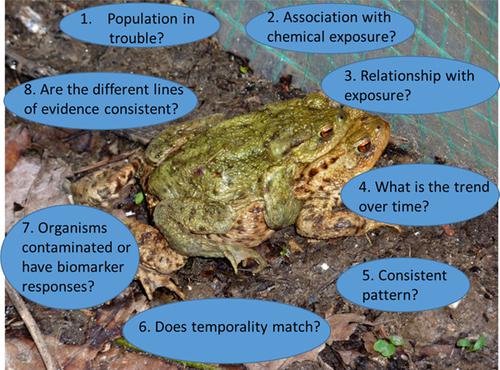当前位置:
X-MOL 学术
›
Environ. Toxicol. Chem.
›
论文详情
Our official English website, www.x-mol.net, welcomes your
feedback! (Note: you will need to create a separate account there.)
The Weight-of-Evidence Approach and the Need for Greater International Acceptance of Its Use in Tackling Questions of Chemical Harm to the Environment
Environmental Toxicology and Chemistry ( IF 3.6 ) Pub Date : 2021-08-04 , DOI: 10.1002/etc.5184 Andrew C Johnson 1 , John P Sumpter 2 , Michael H Depledge 3
Environmental Toxicology and Chemistry ( IF 3.6 ) Pub Date : 2021-08-04 , DOI: 10.1002/etc.5184 Andrew C Johnson 1 , John P Sumpter 2 , Michael H Depledge 3
Affiliation

|
As we attempt to manage chemicals in the environment we need to be sure that our research efforts are being directed at the substances of greatest threat. All too often we focus on a chemical of concern and then cast around for evidence of its effects in an unstructured way. Risk assessment based on laboratory ecotoxicity studies, combined with field chemical measurements, can only take us so far. Uncertainty about the range and sufficiency of evidence required to take restorative action often puts policymakers in a difficult situation. We review this conundrum and reflect on how the “Hill criteria,” used widely by epidemiologists, have been applied to a weight-of-evidence approach (a term sometimes used interchangeably with ecoepidemiology) to build a case for causation. While using a set of such criteria to address sites of local environmental distress has been embraced by the US Environmental Protection Agency, we urge a wider adoption of weight-of-evidence approaches by policymakers, regulators, and scientists worldwide. A simplified series of criteria is offered. Progress will require a sustained commitment to long-term wildlife and chemical monitoring over a sufficient geographic spread. Development of a comprehensive monitoring network, coupled with assembling evidence of harm in a structured manner, should be the foundation for protecting our ecosystems and human health. This will enable us to not only judge the success or failure of our efforts but also diagnose underlying causes. Environ Toxicol Chem 2021;40:2968–2977. © 2021 The Authors. Environmental Toxicology and Chemistry published by Wiley Periodicals LLC on behalf of SETAC.
中文翻译:

证据权重方法和在解决化学对环境危害问题中使用它的国际接受度更高的必要性
当我们试图管理环境中的化学品时,我们需要确保我们的研究工作针对的是威胁最大的物质。我们经常关注一种令人担忧的化学物质,然后以一种非结构化的方式四处寻找其影响的证据。基于实验室生态毒性研究的风险评估,结合现场化学测量,只能让我们走到这一步。采取恢复性行动所需证据的范围和充分性的不确定性常常使政策制定者陷入困境。我们回顾了这个难题,并反思了流行病学家广泛使用的“希尔标准”如何应用于证据权重方法(有时与生态流行病学互换使用的术语)来建立因果关系的案例。虽然美国环境保护署已经接受了使用一套此类标准来解决当地环境问题的地点,但我们敦促全世界的政策制定者、监管机构和科学家更广泛地采用证据权重方法。提供了一系列简化的标准。要取得进展,就需要持续致力于在足够大的地理范围内对野生动物和化学物质进行长期监测。建立一个全面的监测网络,并以结构化的方式收集危害证据,应该是保护我们的生态系统和人类健康的基础。这将使我们不仅能够判断我们努力的成功或失败,而且还能诊断出根本原因。我们敦促全世界的决策者、监管者和科学家更广泛地采用证据权重方法。提供了一系列简化的标准。要取得进展,就需要持续致力于在足够大的地理范围内对野生动物和化学物质进行长期监测。建立一个全面的监测网络,并以结构化的方式收集危害证据,应该是保护我们的生态系统和人类健康的基础。这将使我们不仅能够判断我们努力的成功或失败,而且还能诊断出根本原因。我们敦促全世界的决策者、监管者和科学家更广泛地采用证据权重方法。提供了一系列简化的标准。要取得进展,就需要持续致力于在足够大的地理范围内对野生动物和化学物质进行长期监测。建立一个全面的监测网络,并以结构化的方式收集危害证据,应该是保护我们的生态系统和人类健康的基础。这将使我们不仅能够判断我们努力的成功或失败,而且还能诊断出根本原因。建立一个全面的监测网络,并以结构化的方式收集危害证据,应该是保护我们的生态系统和人类健康的基础。这将使我们不仅能够判断我们努力的成功或失败,而且还能诊断出根本原因。建立一个全面的监测网络,并以结构化的方式收集危害证据,应该是保护我们的生态系统和人类健康的基础。这将使我们不仅能够判断我们努力的成功或失败,而且还能诊断出根本原因。环境毒物化学2021;40:2968–2977。© 2021 作者。Wiley Periodicals LLC 代表 SETAC 出版的Environmental Toxicology and Chemistry 。
更新日期:2021-08-04
中文翻译:

证据权重方法和在解决化学对环境危害问题中使用它的国际接受度更高的必要性
当我们试图管理环境中的化学品时,我们需要确保我们的研究工作针对的是威胁最大的物质。我们经常关注一种令人担忧的化学物质,然后以一种非结构化的方式四处寻找其影响的证据。基于实验室生态毒性研究的风险评估,结合现场化学测量,只能让我们走到这一步。采取恢复性行动所需证据的范围和充分性的不确定性常常使政策制定者陷入困境。我们回顾了这个难题,并反思了流行病学家广泛使用的“希尔标准”如何应用于证据权重方法(有时与生态流行病学互换使用的术语)来建立因果关系的案例。虽然美国环境保护署已经接受了使用一套此类标准来解决当地环境问题的地点,但我们敦促全世界的政策制定者、监管机构和科学家更广泛地采用证据权重方法。提供了一系列简化的标准。要取得进展,就需要持续致力于在足够大的地理范围内对野生动物和化学物质进行长期监测。建立一个全面的监测网络,并以结构化的方式收集危害证据,应该是保护我们的生态系统和人类健康的基础。这将使我们不仅能够判断我们努力的成功或失败,而且还能诊断出根本原因。我们敦促全世界的决策者、监管者和科学家更广泛地采用证据权重方法。提供了一系列简化的标准。要取得进展,就需要持续致力于在足够大的地理范围内对野生动物和化学物质进行长期监测。建立一个全面的监测网络,并以结构化的方式收集危害证据,应该是保护我们的生态系统和人类健康的基础。这将使我们不仅能够判断我们努力的成功或失败,而且还能诊断出根本原因。我们敦促全世界的决策者、监管者和科学家更广泛地采用证据权重方法。提供了一系列简化的标准。要取得进展,就需要持续致力于在足够大的地理范围内对野生动物和化学物质进行长期监测。建立一个全面的监测网络,并以结构化的方式收集危害证据,应该是保护我们的生态系统和人类健康的基础。这将使我们不仅能够判断我们努力的成功或失败,而且还能诊断出根本原因。建立一个全面的监测网络,并以结构化的方式收集危害证据,应该是保护我们的生态系统和人类健康的基础。这将使我们不仅能够判断我们努力的成功或失败,而且还能诊断出根本原因。建立一个全面的监测网络,并以结构化的方式收集危害证据,应该是保护我们的生态系统和人类健康的基础。这将使我们不仅能够判断我们努力的成功或失败,而且还能诊断出根本原因。环境毒物化学2021;40:2968–2977。© 2021 作者。Wiley Periodicals LLC 代表 SETAC 出版的Environmental Toxicology and Chemistry 。











































 京公网安备 11010802027423号
京公网安备 11010802027423号